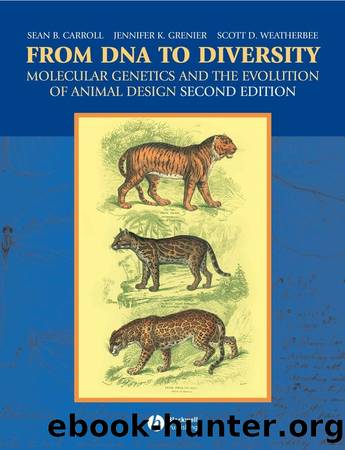From DNA to Diversity by Grenier Jennifer Weatherbee Scott Carroll Sean B. & Jennifer K. Grenier & Scott D. Weatherbee

Author:Grenier, Jennifer, Weatherbee, Scott, Carroll, Sean B. & Jennifer K. Grenier & Scott D. Weatherbee
Language: eng
Format: epub
Publisher: Wiley
Published: 2013-04-15T16:00:00+00:00
Evolution of the genetic control of segmentation in arthropods
Underlying the general similarity of arthropod segmentation are conserved gene expression patterns, which suggests that there may be a common regulatory program for segmentation among arthropods. For example, segmentation in all classes—insects, crustaceans, myriapods, and chelicerates—passes through a stage when the engrailed gene is expressed in a stripe in each segment (Fig. 5.1). In Drosophila , this segment polarity gene—a member of the last tier in the segmentation gene cascade—functions to establish and maintain compartmental and segmental boundaries. In addition, a number of other genes involved in Drosophila segmentation, including even-skipped, hairy, wingless, and runt, are expressed in patterns that appear to be associated with segmentation in several insects, crustaceans, centipedes, and spiders. Thus, some of the members in the Drosophila segmentation cascade appear to be deployed among most arthropods during the segmentation process. However, a number of striking differences are also apparent. These may be related to the differences in early embryonic development between arthropods. In Drosophila, segmentation depends on gradients of transcription factor activity in a syncytial embryo; in other arthropods, segmentation occurs over a longer period in a cellularized embryo.
Figure 5.1 Conservation of segmental engrailed expression in arthropods All arthropods share a segmented body plan. (a) The phylogeny of major arthropod groups is shown with representative animals. (b) The engrailed segment polarity gene is expressed in segmentally iterated stripes during embryogenesis in different arthropods. This similarity indicates that segmental engrailed expression is a conserved stage in the development of all arthropods.
Source: Part b from Patel NH. The evolution of arthropod segmentation: insights from comparisons of gene expression patterns. Development 1994(suppl): 201–207; Telford MJ, Thomas RH. Proc Natl Acad Sci USA 1998; 95: 10671–10675; Hughes CL, Kaufman, TC. Dev Biol 2002; 247: 47–61. Copyright (2002), reprinted with permission from Elsevier.
Download
This site does not store any files on its server. We only index and link to content provided by other sites. Please contact the content providers to delete copyright contents if any and email us, we'll remove relevant links or contents immediately.
Sapiens: A Brief History of Humankind by Yuval Noah Harari(14209)
Sapiens by Yuval Noah Harari(5280)
Pale Blue Dot by Carl Sagan(4883)
Homo Deus: A Brief History of Tomorrow by Yuval Noah Harari(4798)
Livewired by David Eagleman(3663)
Origin Story: A Big History of Everything by David Christian(3631)
Brief Answers to the Big Questions by Stephen Hawking(3354)
Inferior by Angela Saini(3260)
Origin Story by David Christian(3132)
Signature in the Cell: DNA and the Evidence for Intelligent Design by Stephen C. Meyer(3054)
The Gene: An Intimate History by Siddhartha Mukherjee(3029)
The Evolution of Beauty by Richard O. Prum(2924)
Aliens by Jim Al-Khalili(2775)
How The Mind Works by Steven Pinker(2713)
A Short History of Nearly Everything by Bryson Bill(2616)
Sex at Dawn: The Prehistoric Origins of Modern Sexuality by Ryan Christopher(2472)
From Bacteria to Bach and Back by Daniel C. Dennett(2432)
Endless Forms Most Beautiful by Sean B. Carroll(2413)
Who We Are and How We Got Here by David Reich(2385)
